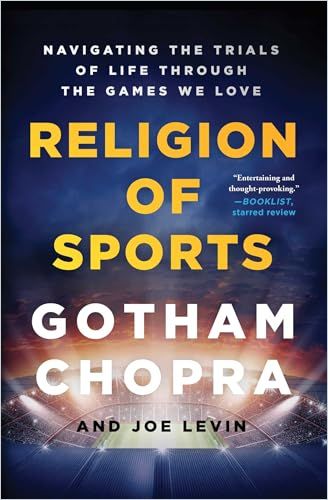Gotham Chopra offers stories from his life and reflections on professional athletes to illustrate how people find spirituality in sports.

Sports As Spirituality
Gotham Chopra — who co-founded the media company Religion of Sports with NFL greats Tom Brady and Michael Strahan — considers why and how sports generate spirituality.
Religious Fervor
Though a record number of Americans are turning away from religion, people naturally gravitate toward traditions, customs, and ideology, and they seek a sense of belonging. Millions of people embrace a religious fervor for sport, seizing on the ability of athletic competitions to offer inspiration in the form of human triumphs. For sports fans, hope springs eternal, and miracles occur. Salvation is right around the corner.
Sports help us look toward the infinite and believe. In ways both small and large, they help us unlock the riddles of life.Gotham Chopra
As a child, author Gotham Chopra – the son of holistic health guru Deepak Chopra – realized that sports gave him a communal connection. He loved all the New England teams, especially the NBA’s Boston Celtics. A family friend and Celtics season-ticket holder, businessman Alan Rosenfeld, invited Chopra to Celtics games at the Boston Garden arena. On one visit, he took Chopra through a private entrance at the Garden, and the boy got to stand on the sidelines, watching in awe as the players warmed up. Superstar forward Larry Bird asked if he would like to retrieve missed shots. Chopra remembers that as a transcendent experience.
Commitment and dedication
In Game Two of the 1986 playoff series between the Celtics and the Chicago Bulls, Chicago’s Michael Jordan scored an NBA playoff record 63 points. Bird described Jordan’s performance as “God-like.” Jordan wasn’t a deity, yet his performance seemed beyond human. Sports, Chopra realized, could provide a religious experience.
Such exceptional athletes embrace a level of commitment and dedication that separates them from everyday people. For example, when he was a youngster, National Hockey League legend Wayne Gretzky always watched games on TV with a pencil in hand. He charted the puck’s movement, decoding where the puck “spent the most time.” Throughout his career, Gretzky demonstrated an uncanny ability to meet the puck as it traveled.
If you want to perform at the highest level, then you have to prepare at the highest level.Gotham Chopra
Tom Brady, the greatest quarterback in NFL history, found comfort in pursuing perfection. He brought footballs and other equipment on vacation with him, rising at dawn to find a field where he could practice. Football allowed Brady to access a sense of personal authenticity that he found difficult to replicate off the field.
In the Zone
Prince Bodhidharma, an Indian Buddhist monk born late in the fifth century, traveled to China to teach Buddhism and the virtues of meditation. He taught temple monks in Henan province’s Shaolin region the movements that became kung fu. Through practice, the monks found they could slow time, quiet the noise in their heads, and achieve a state of flow — an alert, peaceful mindset that promotes contentment and productivity. Athletes call this “being in the zone.”
NBA superstar LeBron James once spent an entire game in the zone. In the 2012 Eastern Conference Finals, his team, the Miami Heat, trailed the Celtics, 3-2. James, locked into the zone, hardly spoke to anyone on the day before the game or on game day. He finished with 45 points, 15 rebounds, and five assists, saving the Heat’s season. James’ physical and mental preparation blended seamlessly into his flow.
Ethics and morality
Chopra involved his son Krishu in multiple youth sports activities, hoping to teach him lessons about integrity, respect, and diligence. At their best, athletes follow a code of moral conduct that condemns cheaters and celebrates sportsmanship.
Coaches use a variety of methods to communicate their messages and can become moral role models. Take P.J. Fleck, for example. In 2012, Western Michigan University made Fleck history’s youngest major college football coach. His slogan, “Row the boat,” appeared everywhere on campus. Fleck selected rowing as a metaphor because it requires coordination among “the oar, the boat, and the compass.” The oar symbolizes people’s energy and enthusiasm; the boat represents their collective sacrifices; the compass helps everyone pull together in the same direction.
Few coaches matched the wizardry of John Wooden, who won 10 national titles and 88 straight games as UCLA’s basketball coach. He created a visual “Pyramid of Success” to teach life lessons to his teams. Wooden’s players could attain “competitive greatness” only after they embraced trustworthiness, collaboration, conviction, and friendship.
Simone Biles
Experts, fans, and the press regard American Simone Biles as the greatest gymnast in Olympic history. In the 2016 Olympics in Rio de Janeiro, she won four gold medals and a bronze. Biles loved her Olympic experience and planned to compete in the 2020 Tokyo Games. But COVID-19 forced a postponement of the Olympics until 2021. Biles found the lockdown depressing. She was unable to find a substitute for the mental and physical discipline she found in gymnastics.
Prior to the COVID pandemic, Team USA doctor Larry Nassar pleaded guilty to sexually abusing multiple gymnasts, including Biles. He received a jail sentence of more than 100 years. In comparison to the abuse he inflicted on other gymnasts, Biles thought she had avoided the worst of it. But one day, while driving in Houston, she pulled off the road and broke down. She called her mother and sobbed on the phone.
A lot of us didn’t go to school. We were homeschooled, so it’s not like we had people to talk about it with. (Simone Biles)
Despite her trauma, Biles was determined to compete in Tokyo. However, she struggled during qualifying, and suddenly discovered — while jumping on her hotel bed — that she couldn’t properly execute a backflip. Unable to overcome her fears or regain her sense of “air space” and her confidence, Biles withdrew from the team competition. Athletes are not supposed to quit – they’re supposed to push forward no matter what. Instead, Biles showed the courage and resilience to honor her own well-being. By doing so, Chopra believes, she “led a reformation in the Religion of Sports.” (Of course, she rebounded to triumph in the 2024 Paris Olympics, where she won gold in the Individual All-Around Artistic Gymnastics final.)
The essence of sports
Chopra’s entertaining and occasionally insightful reflections on the spirituality of sport will resonate with anyone who has yearned for a last-second field goal or a ninth-inning home run. Working with writer Joe Levin, he examines the essence of sports, what fans learn from them, why they matter so much, and how the best athletes achieve greatness. Surprisingly, Chopra spends less time on the devotion and struggles of amateur athletes, even though their fervor also illustrates his themes. As with anyone trying to impart serious spiritual or moral values to sports, Chopra must manifest a devotion that sometimes rings true and other times proves difficult to take seriously. His hero-worship of pro athletes reveals that Chopra’s inner eighth-grader is alive and well. And, for those passages, other eighth-graders may be his most appreciative audience, while business readers will appreciate his ability to draw inspiration from human achievement and teamwork.








